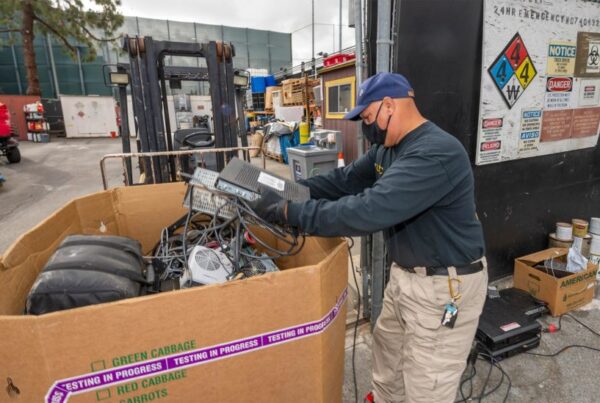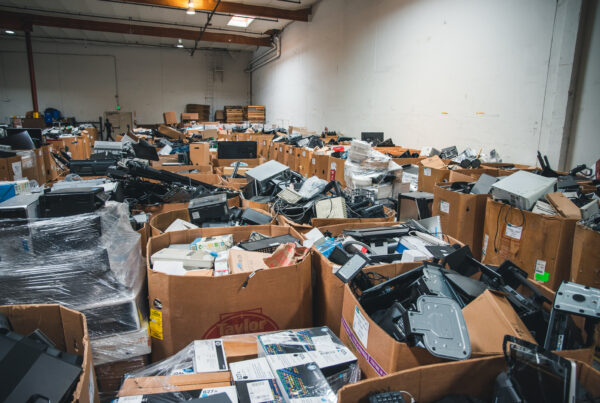New York, a state known for its bustling cities and progressive policies, is no stranger to the growing problem of electronic waste. As technology advances at an unprecedented rate, businesses and consumers alike find themselves grappling with the proper disposal of obsolete devices. The e-waste issue in New York is full of environmental, financial, and legal implications that leave organizations feeling overwhelmed and uncertain.
Within this challenge, however, is a chance to transform the way we view e-waste, to turn a problem into a solution, and to make a positive impact on our environment and our communities. By understanding the inner workings of e-waste regulations in New York, businesses more easily navigate this maze and emerge as leaders in sustainable practices.
Table of Contents
- The Scope and Impact of E-Waste in the Empire State
- New York’s E-Waste Regulations: An Overview
- The Smart Solution: Donating Used Technology to Human-I-T
- Donate Your IT Assets in New York
The Scope and Impact of E-Waste in the Empire State
It’s important to understand what constitutes e-waste and the extensive consequences of improper disposal. E-waste encompasses a wide array of electronic devices that have reached the end of their useful life—from smartphones and laptops to office equipment and household appliances.
These discarded devices may seem harmless but contain hazardous materials posing significant risks to both the environment and human health. Heavy metals like lead, mercury, and cadmium, along with toxic substances, leach into soil and water when e-waste is dumped in landfills. This contamination has devastating effects on ecosystems and even makes its way into our food chain.
The sheer volume of e-waste being generated in New York is staggering. According to the New York State Department of Environmental Conservation, New Yorkers discard over 400,000 tons of e-waste annually. This growing concern demonstrates the urgent need for proper e-waste management practices.
There is hope in these challenges. Each piece of electronic waste holds the potential for a second life. With the right handling and processing, these discarded devices can be refurbished, repurposed, and reintroduced into the cycle of use. This reduces the demand for new products and the environmental impact associated with their production.
New York’s E-Waste Regulations: An Overview
Statewide Regulations and Implications
It’s understandable that traversing the maze of New York’s e-waste regulations is a daunting task for businesses. The Electronic Equipment Recycling and Reuse Act (EERRA) and the Department of Environmental Conservation (DEC) regulations form the backbone of e-waste management in the state. Each has its own set of requirements and potential pitfalls.
Under the EERRA, businesses are prohibited from disposing of electronic waste in landfills or incinerators. Instead, they must ensure that their e-waste is properly recycled or reused through a manufacturer’s take-back program or a certified electronic waste recycling facility. The EERRA also mandates that manufacturers provide free and convenient recycling options for consumers. This shifts the responsibility of e-waste management from the public to the private sector.
The DEC’s supplementary regulations further complicate the picture. For instance, the Cathode Ray Tube (CRT) management requirements dictate that CRTs and CRT-containing devices must be handled and disposed of in a manner that prevents the release of hazardous materials into the environment. This includes proper labeling, storage, and transportation of CRTs to authorized recycling or disposal facilities.
A common misconception is that businesses can simply dispose of their e-waste in the regular trash. However, this is strictly prohibited under New York’s e-waste regulations. Failure to comply with these laws results in severe penalties. The DEC, for instance, is capable of imposing fines of up to $25,000 per violation per day.
To stay compliant, businesses must develop and implement a comprehensive e-waste management plan. This involves identifying all electronic waste generated by the organization, properly storing and labeling the waste, and ensuring that it is transported to a certified e-waste recycling facility or manufacturer’s take-back program. Regularly training employees on proper e-waste handling and disposal procedures is also crucial to maintain compliance.
New York City E-Waste Regulations and Standards
In the “Big Apple,” New York City, the Department of Sanitation (DSNY) has introduced the innovative e-cycleNYC program to provide businesses and residents with convenient e-waste recycling options. This initiative includes apartment building collection for buildings with 10 or more units, numerous drop-off locations citywide, and special collection events held in partnership with local organizations.
These special collection events, such as the Shred-a-thon and e-waste disposal event in Lower Manhattan, offer a secure way for businesses and residents to dispose of sensitive documents and electronic waste. Accepted items include computers, monitors, handheld devices, routers, hubs, modems, keyboards, cables and cords, chargers, mice, circuit boards, printers, fax machines, TVs, VCRs, DVD players, video game systems, cell phones, and A/V equipment. However, it’s important to note that certain items are not accepted at these events, such as batteries, CDs, DVDs, VHS and cassette tapes, household appliances, smoke detectors, and humidifiers/dehumidifiers. This highlights the importance for businesses to properly sort and prepare their e-waste before bringing it to collection events or drop-off locations.
While these services are provided free of charge, businesses must navigate the logistical challenges of storing and transporting their e-waste to the designated collection points. This is particularly cumbersome for organizations dealing with large volumes of electronic waste, requiring significant planning and coordination.
To facilitate the process, the city has installed seven smart bins below Chambers Street, which are accessed using Bluetooth via a free app. Additionally, there are four food scrap drop-off sites in Battery Park City. More information about the smart bins and drop-off sites is found on the Department of Sanitation’s website.
By leveraging these resources and properly preparing their e-waste, businesses in New York City ensure compliance with local regulations while contributing to a more sustainable future. However, the logistical challenges associated with storing and transporting large volumes of electronic waste require careful planning and coordination.
Buffalo E-Waste Regulations and Standards
Buffalo, too, has its own set of e-waste initiatives. The Buffalo Recycling Alliance, in collaboration with the city, organizes regular collection events at easily accessible locations like shopping mall parking lots. These events allow businesses and residents to drop off their electronic waste at no cost.
However, the responsibility is on the businesses to transport their e-waste to these events, which involves transportation and labor expenses. The city also offers year-round drop-off locations, such as the Engineering Garage, but businesses must allocate resources for sorting, storing, and transporting their e-waste to these facilities.
Despite the challenges, participating in local e-waste initiatives is a wise move for businesses. Not only does it ensure compliance with local regulations, but it also showcases a commitment to environmental stewardship, a value that resonates with today’s environmentally conscious consumers and stakeholders.
Progressive businesses view these challenges as opportunities for growth and leadership. By proactively managing their e-waste and staying ahead of the regulatory curve, they position themselves as trailblazers in sustainable practices.
The Smart Solution: Donating Used Technology to Human-I-T
Amidst the complicated network of e-waste regulations in New York, businesses seek solutions that ensure compliance and align with their values of social and environmental responsibility. This is where Human-I-T enters the picture, offering a smart, comprehensive approach to e-waste management that goes beyond mere compliance.
Overview of Human-I-T’s E-Waste Removal Services in New York
Human-I-T’s e-waste removal services take the complexity out of the equation for businesses. At the core of Human-I-T’s approach is our secure transportation and storage process. Devices with data storage are received by authorized Human-I-T personnel at a NAID-certified, secure facility, where they are physically secured and closely supervised until processed.
Human-I-T employs a comprehensive data sanitization process, using NIST 800-88 methods to write random data through the entirety of each device with data storage. Devices are re-scanned, verifying that 100% of all sensitive information has been destroyed. Certificates of data destruction and itemized donation receipts are provided to donors for their records. In cases where data cannot be erased using software, devices are physically crushed and recycled in an environmentally sound manner via an R2-certified organization. Additionally, Human-I-T’s data destruction process is compliant with major data security laws, including HIPAA, GLBA, FACTA, FISMA, PIPEDA, and SOX.
The result is a win-win situation for businesses. They achieve compliance with e-waste regulations, demonstrate their commitment to social and environmental responsibility, and free up internal resources, all while making a positive impact on their community. It’s a smart solution that transforms the challenge of e-waste management into an opportunity for positive change.
As businesses in New York navigate the landscape of e-waste regulations, partnerships with organizations like Human-I-T are increasingly crucial. Embrace the opportunity in e-waste management. Donate your used technology today and be part of the solution to the e-waste crisis and the digital divide.
Together, we can turn the challenges of e-waste management into opportunities for a more sustainable and equitable future.






